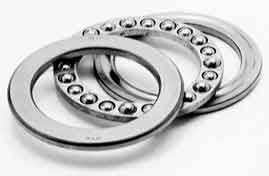
Inspiration
for the “Imperial” Pachinko Ball Bracelet.
A common "captive ball thrust bearing".

| In 1986, while
on vacation in Kyoto, Japan, I visited one of the ubiquitous Pachinko
parlors. These parlors are
quintessential Japanese. They
are everywhere. In large halls lit by large batteries of glaring fluorescent lights, rows and rows of Pachinko machines are set up side by side, and back to back. There are often hundreds of these machines in one parlor. The halls are loud and smoky. Players sit motionless in front of the Pachinko machines and stare at them. With a large knob on the lower right hand side of the machine, they control the velocity with which the small steel pachinko balls are propelled vertically into the machine. These balls then cascade down through the machine and their direction is deflected by a maze of pins that stick out from the surface of the colorful background of the machines. Most balls will just fall to the bottom, and disappear. Some balls however, are deflected into holes. Depending on which holes the balls disappear into, one can win multiple new balls. Balls can be exchanged for mostly worthless trinkets and goods at a counter. The theory is, that if the velocity with which the balls are shot into the machine is constant, the hole into which the balls will disappear will be the same. In practice this does not work of course, but nevertheless, Japanese men (mostly) and woman alike, spend many hours in front of these machines, staring at them with their right hands holding onto that knob. I like to call playing Pachinko “mechanized meditation”, because it seems that the players are totally one with the machines and not at all consciously aware of their surroundings. I also played Pachinko, and was bored with it in about 10 minutes. It was just too loud and too smoky in there for me to enjoy it. I had more fun watching the people. Besides, I had lost all my balls within minutes (hmmm, interesting metaphor). With the thought, that I might want to make a piece of jewelry with them at some point, I did take a number of balls with me as a souvenir. Pachinko parlors often put the name of the parlor on the balls in Katakana, one of the Japanese alphabets used to write foreign words. The Pachinko parlor I visited was the “Royal” in Kyoto, and the balls had the word “Royal” on it in Katakana. Several years later, I ran into a friend and colleague at a show, and noticed that she was wearing an interesting bracelet. The bracelet she was wearing, was nothing more than a large industrial, so called “thrust bearing”. (see above). When I saw that “bracelet”, the design for my pachinko ball bracelet came immediately crystal clear into my head. I never needed to draw it. Upon my return home, I immediately started to make of model of the basic element of the bracelet. After a few tries, I had a good working model, after which I started making the bracelet. As you’ll see in the process images, one part of this model was also necessary as a tool (a drilling jig) in making the bracelet. The final bracelet was my “Royal” Pachinko Ball Bracelet (completed in 1992), which is now part of the permanent collection of the Oakland Museum of California, in Oakland, California. Several years later, I was asked by a collector to reproduce the bracelet for her. Since I had several more Pachinko balls sent to me by a business associate in Japan, I agreed. These process pages are about the making of that sister bracelet, the “Imperial” Pachinko Ball Bracelet. This bracelet was completed in 2002. |